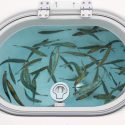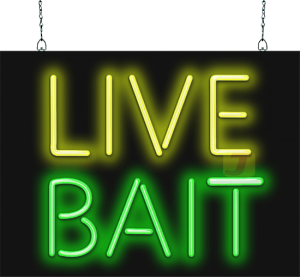Your cart is currently empty!
How to Catch Red Drum with Natural Bait

Using live bait to catch redfish
Live bait is a fantastic way to catch redfish. Red fish will readily take a range of live baits. Croakers, menhaden, spot, pinfish, mullet and small scaled sardines are all appropriate selections for redfish. Many red drum are caught every year on live shrimp, crabs, and blood worms as well.
Live bait is fished either free-lined, below a popping cork, or on a slip-lead rig. A popping cork is the favored approach in shallow water with low visibility or at night. A free-lined bait is a better choice for clearer shallow waters during the day. A slip lead ought to be used when fishing deeper water, or in areas with a lot of current, to hold the bait down in the water column and in the strike zone.
Redfish respond nicely to chum. Setup on the up-current aspect of the structure, and let your chum line float back to the structure to entice the reds and/or bait fish to your location. Any kind of structure can have reds close to it, however oyster beds, grass beds, sandbars, and dock pilings are normally your best bet.
Use shrimp heads, ground fish, or ground crab meat combined with cornmeal to attract them. Menhaden milk or oil is additionally a suitable attractant. If you do not feel like messing with ground fish or menhaden oil, a couple of cans of cat food can make a first rate chum line. Punch a few holes in the top of the can, and suspend it in the water. Give the can a shake every now and then and you are on your way. Alternately, you can chum up the bait fish that the reds like to feed on. Use a combination of cornmeal and bread balls to get the bait fired up. By pulling the bait fish away from their hiding places, you supply the reds with an opportunity to feed.

If you are going to go the chumming route, I advocate waiting till you have the fish fired up in the chum line before drifting back a bait. You additionally want to use a free-lined bait when chumming so that your bait drifts back naturally with the chum. It is essential to hold slack in the line for the same reason. Once the fish hits the line will come tight, and by means of the usage of circle hooks the hook will set itself. Still, after the fish is on a mild jerk can make certain an excellent hook set.
If you do not use chum, you want to get your baits to the redfish. Look for them close to structure. Work the lee side of bars and pilings for first-class results. When fishing deeper water structure with a slip lead, fish the lee facet (down-current) and depart a little bit of slack in the line as soon as the lead hits the bottom. If a red drum picks up the bait and immediately feels strain it might drop the bait rather than eat it.
Live-bait trolling can be a very fine way of discovering redfish, in particular when they are scattered. Your trolling velocity ought to be just enough to hold steerage, about 1 kt or less. In shallow water a trolling motor is even better, given that it does not disturb the fish the way a gasoline or diesel engine will. Troll alongside the edges of grass beds, sandbars, oyster bars, and other redfish holding structures. Good options for trolled baits are shrimp (hook them thru the horn), mullet, and different hardy baitfish. Crabs typically do not make a proper presentation when trolling.
A couple of notes about the use of crabs for bait. First, make sure that any crab you use for bait is legal. Each state has unique rules, so be certain to take a look at your state’s legal guidelines before the use of any species of crab as bait. Some people like to do away with the crabs’ claws to improve hit rates. While I’m not certain it has any impact on the bite, getting rid of the claws does make it a lot less complicated to take care of the baits. And it gives a handy place to place the hook; simply run the hook into the socket from the place you removed the claw. If you aren’t positive you will use all the crabs you have for bait and plan on releasing them after fishing, the use of a rubber band to preserve the claws closed can lead to fewer pinched fingers when getting a new bait out of the live well or bait bucket.
Crabs must be kept on a short leash. Keep them away from structure or they will hole up in cover and never be eaten.
Dead Bait for Reds
Redfish are easily enticed to take a range of dead baits as well. Chunks of mullet or different bait fish work well. Peeled shrimp are some other favorite. If you are having trouble with ‘trash’ fish consuming the baits when you are focused on bull reds, butterflying the bait may additionally make it too big for trash fish to eat, whilst the big red will have no trouble swallowing the bait.
Dead baits are nearly always fished on a slip-lead setup, to maintain the bait in one spot, permitting the scent to draw the redfish to it. A 24-36 inch chief is ideal. Leave a bit of slack in the line, just as you would with live baits, to enable the red to pick up and eat the bait.

The exception to this is if you are fishing a chum slick. If you are fishing with chum, drift a chunk lower back via the chum line with no weight on it to enhance your probabilities of a hook-up.
Leave a Reply